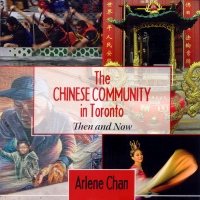| ________________
CM . . .
. Volume XX Number 9. . . .November 1, 2013
excerpt:
Chan, a retired librarian, is a third generation Chinese-Canadian. Her parents were restaurateurs in Toronto who knew many of the city’s most influential Chinese community leaders. Chan’s previous works for children include Spirit of the Dragon, a biography of her mother Jean Lumb and Awakening the Dragon, a book about dragon boat racing. Her work for adults, The Chinese in Toronto from 1878 (Dundurn, 2011) draws upon extensive library research and personal contacts. Some historic data and illustrative matter from this volume reappears in the current work, but it is not really a stripped-down version of the former. The Chinese Community in Toronto: Then and Now does not focus exclusively on Toronto. Chan frequently addresses the broader topic of the Chinese history in Canada as she describes the waves of Chinese immigration to Canada as a whole and the shameful exclusion period when discriminatory federal law prevented Chinese men from bringing their wives and children to Canada. Additionally, descriptions of cultural traditions and beliefs and the important roles of family, county and political associations to early Chinese immigrants may draw upon some local examples but apply to Chinese communities in other cities too. The book follows a general chronological fashion, beginning with the arrival of gold miners and then railroad workers in British Columbia in the late nineteenth century and early settlement in Toronto from 1878 to 1922 when laundries and restaurants were the major sources of employment for the Chinese. Chapters on life in Chinatown and a child’s life focus mainly on the period of the 1920s and 1930s. The Chinese in Canada and the two world wars includes a little known tale of the Chinese Labour Corps of World War I that were secretly transported across Canada to aid the Allied effort in France, as well as the better known stories of Chinese participation in World War II and support for the war through the purchase of war bonds and subsequent demands for the end of discrimination and rights to citizenship. The post-war years cover a huge swath of history, including family reunification, the establishment of relations between Canada and the Communist government of the People’s Republic of China, and immigration from Hong Kong, ethnic Chinese from Vietnam and Southeast Asia, from Taiwan and from mainland China. Three final chapters look more closely at the explosion of Chinatowns in the Greater Toronto Area, contemporary socio-economic conditions and an introduction to some noted Toronto-based Chinese Canadians. Many black and white photographs and illustrations appear throughout the work, along with sidebar profiles with brief biographical sketches of Chinese Canadians, and a few historical “Did you know?” sidebars exploring historical matters. For more advanced readers, there are endnotes and a good bibliography that includes an assortment of books, both fiction and non-fiction, mostly age appropriate, and websites. One omission from the bibliography is Paul Yee’s fictional diary of a teenage railroad worker in Blood and Iron: Building the Railway. Additional features are maps, tables to display numeric data, a glossary, chronology, and an adequate index. One glaring oversimplification unfortunately verges on the erroneous. The Chinese labourers who were brought to Canada to help build the Canadian Pacific Railroad worked on the segment that the American contractor Onderdonk agreed to build, the section from the Pacific coast through the Rocky Mountains. The book may leave readers with the impression that the Chinese workers helped build the entire railroad. A sidebar reference to Gordon Lightfoot’s magical “Canadian Railroad Trilogy” is not especially helpful if one considers that he refers to “navvies” working on the railroad, but never specifically mentions any of the ethnic origins of the workers or the segments that they helped build. Chinese support for the Second World War in the form of the purchase of victory bonds is undisputed, but Chan could have qualified this by noting that some contributions to these purchases and the war bonds of the Nationalist government in China were not voluntary but due to coercion, as noted in her other book. Her description of the amalgamation of distinct municipalities into the megacity of Toronto in 1998 glosses over the complex metropolitan level of government that had been in place and that administered a police force citywide and operated a reference library and a metropolitan school board prior to amalgamation. The inclusion of historic developments in China helps to explain emigration and the familial roots that Chinese immigrants to Canada held, but the amount of international and national history included does not always mesh well with the attempt to focus upon the local communities in Toronto. Chan seems to be overly ambitious in this undertaking. One of the great gifts of the work is the introduction, however briefly, of personal stories of many of Toronto’s early Chinese and Chinese Canadian residents. Recommended with reservations. Val Ken Lem, a librarian at Ryerson University in Toronto, ON, is a second-generation Chinese Canadian on his father’s side and descended from continental European settlers and First Nations people on his mother’s side.
To comment
on this title or this review, send mail to cm@umanitoba.ca.
Copyright © the Manitoba Library Association. Reproduction for personal
use is permitted only if this copyright notice is maintained. Any
other reproduction is prohibited without permission.
NEXT REVIEW |
TABLE OF CONTENTS FOR THIS ISSUE
- November 1, 2013.
AUTHORS |
TITLES |
MEDIA REVIEWS |
PROFILES |
BACK ISSUES |
SEARCH |
CMARCHIVE |
HOME |
